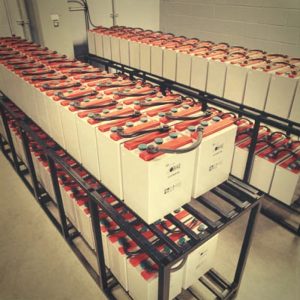Battery Selection for Alternative Energy Electricity Generation
Designing a residential wind or solar power system requires many engineering considerations. One of the biggest decisions is whether to design a grid-tied (GT) or off-the-grid (OTG) system. This decision is a prime motivator in design of the battery storage system. A professional can design and install an appropriate system for each unique situation.
A typical GT system feeds excess electricity back into the power grid, running the consumer’s meter backwards. If the grid is available, it is also used to supply power to the home if necessary. OTG systems rely totally on themselves and backup generators to supply electricity needs. Either system may use batteries to store energy, but going OTG requires battery storage.
Sizing the Battery Bank
 There are several technical issues to be considered when sizing components for an alternative energy system. Within each of these areas, the desired balance of product quality and cost must be balanced for the battery bank.
There are several technical issues to be considered when sizing components for an alternative energy system. Within each of these areas, the desired balance of product quality and cost must be balanced for the battery bank.
- The first step for designing any GT or OTG system is to determine the required power. Online worksheets and professional consultation are available options.
- The capacity of the battery bank depends on how many hours or days of power need to be stored for later usage.
- Several different types of batteries are available: deep-cycle lead-acid batteries are common because of low initial cost but require periodic maintenance; sealed deep-cycle lead-acid batteries cost more but are virtually maintenance free; sealed gel-cell batteries are also maintenance free but require close monitoring of charge state.
- Temperature has a major effect on battery efficiency. Most batteries operate best around 75 degrees F. At 40 degrees, lead-acid batteries efficiency drops to 75 percent. High temperatures can substantially reduce the life of batteries.
- Controlling discharge to only 50 percent can significantly improve battery life.
- Appropriate inverter and controller selection will protect and increase the life of batteries. There are several combination inverter/controller systems available. Generally, price increases as the rated size of the system increases.
Check Out: Backup Power Home Energy Generator
Are Batteries Essential for Residential Systems?
The short answer, for GT systems, is no. For OTG systems, a bank with several days capacity is often used in conjunction with a generator to charge batteries when necessary. However, like the system itself, the need for batteries should be determined separately for each case.
In a GT system a smaller battery bank may be desirable. Residential electricity usage generally peaks in the early morning and in the evening when people are home from work and using more appliances and lighting. To supply electricity during these times, when sunlight is scarce, a solar system would probably integrate some battery storage.
The cost of a battery bank is generally substantial. Thus, the rate paid by utility providers for excess electricity should be considered. If a consumer electrical meter is run backwards enough during sunny/windy (peak) times, it could offset electricity used by a GT system during off-peak times.
There are many considerations that affect the appropriate design of residential wind or solar power components. The best way to get peak performance from an individual system is to enlist professional help. With some guidance, green energy options for home owners can provide affordable options to electricity generated with fossil fuels.



Comments are closed, but trackbacks and pingbacks are open.